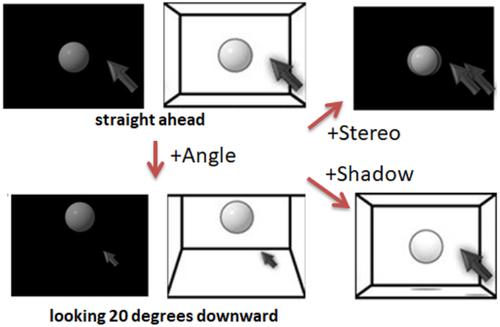当前位置:
X-MOL 学术
›
J. Soc. Inf. Disp.
›
论文详情
Our official English website, www.x-mol.net, welcomes your feedback! (Note: you will need to create a separate account there.)
The effects of depth perception viewing on hand–eye coordination in virtual reality environments
Journal of the Society for Information Display ( IF 2.3 ) Pub Date : 2021-06-23 , DOI: 10.1002/jsid.1068 Lai-Yu Cheng, Chiuhsiang Joe Lin
Journal of the Society for Information Display ( IF 2.3 ) Pub Date : 2021-06-23 , DOI: 10.1002/jsid.1068 Lai-Yu Cheng, Chiuhsiang Joe Lin

|
Virtual reality (VR) has been applied to many fields such as visualization, architecture, education, medical science, and sports simulation. Recent VR advancements allow direct manipulation of three-dimensional (3D) objects in interactive displays, but problems of inefficiency in movement due to inaccuracy in depth perception have been reported. As human interaction in virtual environments (VE) is being realized, factors that may affect depth perception and movement need to be addressed. This study investigated the effects of viewing angle, stereo viewing technology, and visual cues on hand movement performance in a 3D movement task. Ten right-handed participants performed continuous Fitts' pointing tasks using a computer mouse. Participants were asked to move a cursor to a target ball as quickly as possible. Fitts' law was employed to test effects to capture differences while the hand was moving in the 3D space under three factors, angle of declination, visual depth, and space cue and with varied index of difficulty (ID). Movement time (MT), error rate, and throughput (TP) were recorded as dependent variables. This study found significant effects of angle of declination, visual depth, space cue, and ID. This study investigated the effectiveness of hand movements in 3D environments for a further immersive VE using a two-dimensional (2D) mouse. Potential applications of this research include the design of interactive 3D display interfaces in which fast and accurate selection is required and the manipulation of 3D objects in 3D environments may be expected.
中文翻译:

虚拟现实环境中深度感知观看对手眼协调的影响
虚拟现实(VR)已被应用于可视化、建筑、教育、医学、运动模拟等诸多领域。最近的 VR 进步允许在交互式显示器中直接操纵 3D (3D) 对象,但已经报告了由于深度感知不准确而导致运动效率低下的问题。随着虚拟环境 (VE) 中的人类交互得以实现,需要解决可能影响深度感知和运动的因素。本研究调查了视角、立体观看技术和视觉提示对 3D 运动任务中手部运动性能的影响。十名惯用右手的参与者使用计算机鼠标连续执行菲茨的指点任务。参与者被要求尽快将光标移动到目标球上。菲茨的 在三个因素下,当手在 3D 空间中移动时,使用定律来测试捕捉差异的效果:偏角、视觉深度和空间提示以及不同的难度指数 (ID)。移动时间 (MT)、错误率和吞吐量 (TP) 被记录为因变量。这项研究发现了偏角、视觉深度、空间提示和 ID 的显着影响。本研究使用二维 (2D) 鼠标调查了 3D 环境中手部运动的有效性,以实现进一步的沉浸式 VE。这项研究的潜在应用包括交互式 3D 显示界面的设计,其中需要快速准确的选择,并且可以预期在 3D 环境中操纵 3D 对象。偏角、视觉深度和空间提示以及不同的难度指数 (ID)。移动时间 (MT)、错误率和吞吐量 (TP) 被记录为因变量。这项研究发现了偏角、视觉深度、空间提示和 ID 的显着影响。本研究使用二维 (2D) 鼠标调查了 3D 环境中手部运动的有效性,以实现进一步的沉浸式 VE。这项研究的潜在应用包括交互式 3D 显示界面的设计,其中需要快速准确的选择,并且可以预期在 3D 环境中操纵 3D 对象。偏角、视觉深度和空间提示以及不同的难度指数 (ID)。移动时间 (MT)、错误率和吞吐量 (TP) 被记录为因变量。这项研究发现了偏角、视觉深度、空间提示和 ID 的显着影响。本研究使用二维 (2D) 鼠标调查了 3D 环境中手部运动的有效性,以实现进一步的沉浸式 VE。这项研究的潜在应用包括交互式 3D 显示界面的设计,其中需要快速准确的选择,并且可以预期在 3D 环境中操纵 3D 对象。这项研究发现了偏角、视觉深度、空间提示和 ID 的显着影响。本研究使用二维 (2D) 鼠标调查了 3D 环境中手部运动的有效性,以实现进一步的沉浸式 VE。这项研究的潜在应用包括交互式 3D 显示界面的设计,其中需要快速准确的选择,并且可以预期在 3D 环境中操纵 3D 对象。这项研究发现了偏角、视觉深度、空间提示和 ID 的显着影响。本研究使用二维 (2D) 鼠标调查了 3D 环境中手部运动的有效性,以实现进一步的沉浸式 VE。这项研究的潜在应用包括交互式 3D 显示界面的设计,其中需要快速准确的选择,并且可以预期在 3D 环境中操纵 3D 对象。
更新日期:2021-06-23
中文翻译:

虚拟现实环境中深度感知观看对手眼协调的影响
虚拟现实(VR)已被应用于可视化、建筑、教育、医学、运动模拟等诸多领域。最近的 VR 进步允许在交互式显示器中直接操纵 3D (3D) 对象,但已经报告了由于深度感知不准确而导致运动效率低下的问题。随着虚拟环境 (VE) 中的人类交互得以实现,需要解决可能影响深度感知和运动的因素。本研究调查了视角、立体观看技术和视觉提示对 3D 运动任务中手部运动性能的影响。十名惯用右手的参与者使用计算机鼠标连续执行菲茨的指点任务。参与者被要求尽快将光标移动到目标球上。菲茨的 在三个因素下,当手在 3D 空间中移动时,使用定律来测试捕捉差异的效果:偏角、视觉深度和空间提示以及不同的难度指数 (ID)。移动时间 (MT)、错误率和吞吐量 (TP) 被记录为因变量。这项研究发现了偏角、视觉深度、空间提示和 ID 的显着影响。本研究使用二维 (2D) 鼠标调查了 3D 环境中手部运动的有效性,以实现进一步的沉浸式 VE。这项研究的潜在应用包括交互式 3D 显示界面的设计,其中需要快速准确的选择,并且可以预期在 3D 环境中操纵 3D 对象。偏角、视觉深度和空间提示以及不同的难度指数 (ID)。移动时间 (MT)、错误率和吞吐量 (TP) 被记录为因变量。这项研究发现了偏角、视觉深度、空间提示和 ID 的显着影响。本研究使用二维 (2D) 鼠标调查了 3D 环境中手部运动的有效性,以实现进一步的沉浸式 VE。这项研究的潜在应用包括交互式 3D 显示界面的设计,其中需要快速准确的选择,并且可以预期在 3D 环境中操纵 3D 对象。偏角、视觉深度和空间提示以及不同的难度指数 (ID)。移动时间 (MT)、错误率和吞吐量 (TP) 被记录为因变量。这项研究发现了偏角、视觉深度、空间提示和 ID 的显着影响。本研究使用二维 (2D) 鼠标调查了 3D 环境中手部运动的有效性,以实现进一步的沉浸式 VE。这项研究的潜在应用包括交互式 3D 显示界面的设计,其中需要快速准确的选择,并且可以预期在 3D 环境中操纵 3D 对象。这项研究发现了偏角、视觉深度、空间提示和 ID 的显着影响。本研究使用二维 (2D) 鼠标调查了 3D 环境中手部运动的有效性,以实现进一步的沉浸式 VE。这项研究的潜在应用包括交互式 3D 显示界面的设计,其中需要快速准确的选择,并且可以预期在 3D 环境中操纵 3D 对象。这项研究发现了偏角、视觉深度、空间提示和 ID 的显着影响。本研究使用二维 (2D) 鼠标调查了 3D 环境中手部运动的有效性,以实现进一步的沉浸式 VE。这项研究的潜在应用包括交互式 3D 显示界面的设计,其中需要快速准确的选择,并且可以预期在 3D 环境中操纵 3D 对象。



























 京公网安备 11010802027423号
京公网安备 11010802027423号